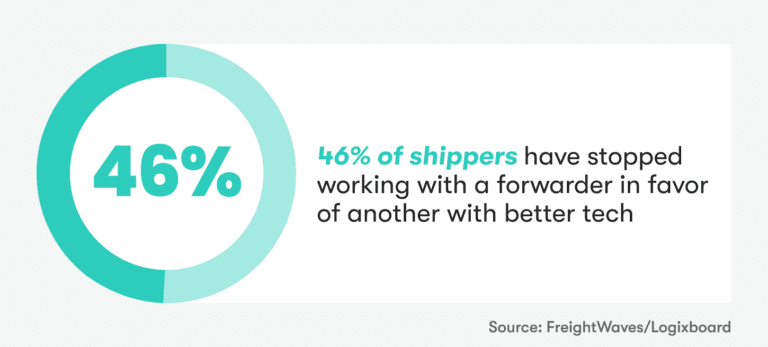In this article
With 72.6% of total domestic tonnage transported by truck in 2022, it’s hard to overstate the importance of truck freight in the global economy. However, despite its value, the sector continues to be bogged down by inefficiency and legacy technology.
Trucking operators in today’s landscape have their work cut out for them, between fielding customer requests and scouring a mess of data sources to piece together a shipment status. Still, amid these challenges, emerging self-serve software stands to offer a solution to these challenges.
Let’s talk about how implementing a customer-facing platform can help take the burden off of operators while simultaneously providing customers with an improved experience.
The Struggle of Domestic Trucking Operators
When it comes to the challenge of being a domestic trucking operator – the problem is two-fold. On one hand, you need to directly serve customers in a landscape of rapidly advancing tech. However, at the same time, you often need to manage the inefficient processes of calling carriers, checking track and trace, referencing paper documents, and more.
Operating in a landscape of rising expectations
Customers are surrounded by technology in their personal, social, and professional lives which impacts their expectations of what visibility technology should be at their finger tips. Notably, major delivery players like Uber and Amazon have set high standards by offering real-time tracking from departure to the final mile.
In turn, many shippers contrast this seamless experience with the more fragmented process they undergo with their own logistics providers. LeAnne Coulter, VP of Freight Management at Penske Logistics, expressed this sentiment to Transport Dive, “I can see when my package is supposed to arrive at my house. Why can’t I see that from all of my truckload and LTL carrier base?”
This mismatch between customer expectations and the reality of manual tracking systems leads to mounting frustration for both shippers and operators alike. It also highlights the resource gap between small and large organizations, as many smaller companies lack the funds to invest in precise tracking technology.
As a result, operators at smaller companies may struggle to provide customers with the complete visibility they expect. At the same time, shippers may feel forced into switching providers due to superior technology alone.
Navigating manual processes for shipment information
In recent years, the domestic trucking space has seen an overall improvement in visibility due to new policies and advancements. For instance, ELD mandates require drivers to maintain their driving logs using an approved electronic device, improving accuracy and standardization across the board. However, the industry still has a long way to go, as operators still face many challenges tracking down their shipments on the road.
Particularly when dealing with smaller carriers, freight forwarders typically don’t have access to technology that would give them a clear, snapshot picture of their shipment status. In a fragmented industry, “small” operations make up an overwhelming majority of carrier options.
According to April 2023 data from the U.S. Department of Transportation, 95.8% of active US motor carriers operate 10 or fewer trucks. Therefore, by limiting their options to tech-forward carriers, forwarders would write off a significant portion of the industry
In response to this issue, many forwarders are now embracing novel tools and streamlined processes to keep their customers well-informed while alleviating the burden of excessive manual work.
After all, you can have the most accurate tracking data, but without a single place to access it, it’s still up to you to piece it all together. For that reason, many domestic trucking providers are starting to adopt self-serve technology to alleviate burnout and streamline operations.
With this solution, customers can access their own portal to view all available information related to their shipments, removing a link in the chain of communication. Not only can customers get 24/7 access to their up-to-date shipment status, but their operators can also cut down on responsibilities like ad hoc phone calls and searching for information.
Enhanced customer experience
By implementing a self-serve solution, you can empower your customers to view and manage their domestic shipment journey on their own. Some available solutions will even provide status updates as they’re available in your system, providing shippers with complete visibility into their shipments.
Rather than calling their logistics partner in a panic about when their shipment will arrive at its destination, they can log into their platform to see the same view as their operator. This heightened transparency fosters trust and satisfaction, leading to stronger customer relationships and increased loyalty.
Streamlined communication
One of the primary challenges faced by trucking operators is the constant need for communication among various stakeholders. On one hand, they’re fielding anxious calls from shippers asking for updates, and on the other, they’re searching through their email for the latest documents from their carrier. Self-serve technology tackles this issue head-on by automating and streamlining communication processes.
To start, as we discussed, providing a customer-facing platform can directly solve a major part of this issue by eliminating the need for ad hoc updates in many situations. Additionally, some self-serve solutions may even include a feature for in-app messaging, which centralizes their communications so they don’t need to search across channels for the latest message. In turn, by freeing up time and minimizing communication bottlenecks, this technology empowers operators to focus on higher-value tasks.
Centralized shipment information
Domestic trucking is known industry-wide for its fragmented mix of stakeholders and data sources. This complexity can lead to confusion and inefficiencies for trucking operators.
However, self-serve technology centralizes all shipment information within a single, user-friendly interface. Operators can upload and access comprehensive and up-to-date details about each shipment, including pickup and delivery dates, cargo details, related documentation. This centralized approach not only streamlines data retrieval but also minimizes the risk of errors and miscommunications caused by handling multiple disparate systems.
Taking the Next Step: Implementing Your Solution
Finding the right provider for your self-serve solution is no easy task. With the range of self-serve options available, it’s important to know what you’re looking for before you start your search.
When building your 3PL tech stack, you’ll want to ask a few key questions to evaluate each solution:
- How does this software integrate with my current technology?
- What will my team be able to incorporate this solution into their processes?
- How much time will this take to get up and running?
- How quickly will I see time to value?
- What will I need to do to see ROI at this price point?
The adoption of self-serve technology holds the key to revolutionizing the domestic trucking industry. Today’s solutions merely scratch the surface of what’s to come, paving the way for a more efficient and customer-centric future.
Still, getting an early start will put you ahead of the competition as the industry continues to advance. With careful planning, thoughtful implementation, and a commitment to ongoing improvement, your business can flourish in the digital age and embrace the full potential of self-serve software.
If you’re looking for a self-serve domestic trucking solution that integrates seamlessly into your TMS, talk to our team about upgrading your customer experience with Logixboard.



